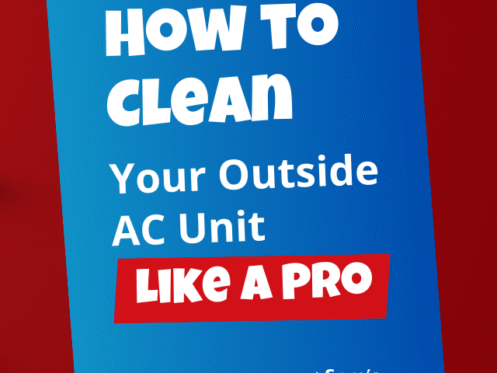Did you know that there’s a simple household job that takes just a few hours a year but could save you hundreds or thousands in energy bills and repair costs? In this guide, we explain how to clean an outside AC unit and why it’s crucial for energy efficiency and system lifespan. We’ll cover all the necessary tools and materials, provide step-by-step instructions on how and when to perform the task, and offer prevention tips to help you avoid AC system issues in the future.
Why Cleaning Your Outside AC Unit Matters
Before we explain how to clean an AC unit’s outside components, let’s discuss why it’s important. Your outdoor AC unit, also known as the AC condenser, is responsible for intaking air from outside, where it’s then cooled and sent into your home. Because they take in air from outdoors, they also collect other things from the surrounding air, such as dirt, dust, grass clippings, leaves, pollen, and other debris.
Over time, these foreign objects enter the system and begin to clog it. This is why cleaning your AC condenser is such an important part of routine HVAC maintenance. Without this important upkeep, you run a few AC risks.
Increased energy costs
The more debris clogs your AC airflow, the harder the system has to work. This results in higher energy consumption, which in turn drives up utility bills as your air conditioner struggles to operate normally.
More repairs
Debris in your system puts added strain on the components, wearing them out faster and making a problem more likely. This can cause a system shutdown or other related issues, meaning you’ll be paying for AC repair on your system prematurely.
Reduced system lifespan
The stress and strain of a dirty AC condenser can do irreparable damage to the system over time, shortening its overall lifespan from the normal period of 10 to 15 years and forcing you to pay for a replacement much sooner.
IAQ problems
Your air conditioner brings air from outside into your home, so naturally, if that air is full of debris, it can have a negative effect on your indoor air quality, or IAQ. This can circulate dust and other allergens, making your space uncomfortable for people with asthma and other respiratory concerns.
Tools & Materials You’ll Need
Now that we know why it’s important to clean your outside AC condenser, let’s look at the things you’ll need to get the job done. You’ll need:
- Protective work or garden gloves
- Gardening shears
- Garden hose with low-pressure spray setting
- Screwdriver
- Shop vacuum
- Soft bristle brush
- Foaming AC coil cleanser
How To Clean an Outdoor AC Unit
With your tools and materials together, it’s time to get started on this vital AC maintenance job. Here’s a step-by-step guide on how to do it:
- Step one: Turn off the power to your unit to prevent electrical accidents and ensure your safety.
- Step two: Put on your protective gloves and carefully remove any larger leaves or twigs from the exterior of the AC condenser by hand. Be careful, as the fins can be sharp enough to cut through some gloves.
- Step three: Inspect the area around the unit for overgrown grass or shrubs. Using gardening shears or any method you prefer, clear a 1-foot radius around the condenser unit to help avoid excess debris from entering the unit in the future.
- Step four: Using your AC manufacturer’s instructions and your screwdriver, remove the top cover of the unit to access the coils inside.
- Step five: Use your gloved hands to remove any large clumps of grass, twigs, and any other large debris from inside the condenser.
- Step six: Use your shop vacuum cleaner to clean out any dust, dirt, or other debris too small to grab by hand. Be careful not to damage any components with the vacuum.
- Step seven: Use your soft-bristled brush to gently clear any dust or debris on the condenser coils themselves. Be very careful, as these components can be delicate.
- Step eight: Next, clean your outside AC coils. Spray your foaming AC coil cleanser directly onto the coils. Check your specific product for instructions on how long to leave it on (usually 5 to 10 minutes). Make sure you’re wearing gloves, as these products should not come into contact with your skin.
- Step nine: Use a low-pressure hose to remove the cleanser from the coils. Be very careful not to get any electric components wet.
- Step ten: Replace the AC condenser cover and refasten the screws.
- Step eleven: Allow the unit to completely air-dry.
- Step twelve: Turn the power back on to your unit, and enjoy your clean, efficient air conditioner!
How Often Should You Clean Your Outside AC Condenser?
Generally, we recommend cleaning your air conditioner’s outdoor condenser at least once a year. Ideally, you should do this in early spring before you need to use your air conditioner daily through the summertime. However, it’s worth doing this more often if you notice certain issues with your air conditioner.
If you notice a musty smell from your AC, it could be a sign of excess dust getting into the system from outside. Cleaning the outdoor unit can also help if your system isn’t blowing cold air (caused by airflow blockages). This is also a good first step to try and fix a freezing air conditioner, as blocked airflow can allow ice to form.
In short, we recommend cleaning your outdoor AC unit once a year, whether you’re dealing with an issue or not, as it will boost energy efficiency and improve the overall performance of the system. We also suggest trying it as a first resort if you’re noticing issues with the system. If cleaning the outdoor unit doesn’t resolve your problem, it’s probably time to contact an HVAC repair pro for help.
How To Keep Your Outside AC Unit Clean Longer
Cleaning an outdoor AC unit is a fairly straightforward job, but it’s still a messy and time-consuming task that you probably don’t want to be doing all the time. You can help keep your AC clean for longer with a few simple tips, such as:
- Regularly check the outside of your unit for any visual debris (especially in spring and summer) and remove it before it gets pulled deeper into the system.
- Give the unit’s exterior a quick rinse with a low-pressure hose whenever you’re outside watering the garden, helping to cut down on dust in the system.
- Change your AC air filters every 2 to 3 months (or as often as the manufacturer suggests) to keep outdoor debris from affecting indoor air quality.
- Invest in an air conditioner cover that protects the top of the unit without trapping moisture, and place it on your unit when it’s not in use in fall and winter.
How Sam’s Air Control Keeps Your AC Running Smoothly
Cleaning your outdoor AC unit is a simple but important task, but it’s not the only part of an effective AC maintenance routine. If you’re looking to get help with your system to ensure high energy efficiency and optimal performance, the team at Sam’s Air Control can help. Learn more about our HVAC maintenance services by getting in touch today.


